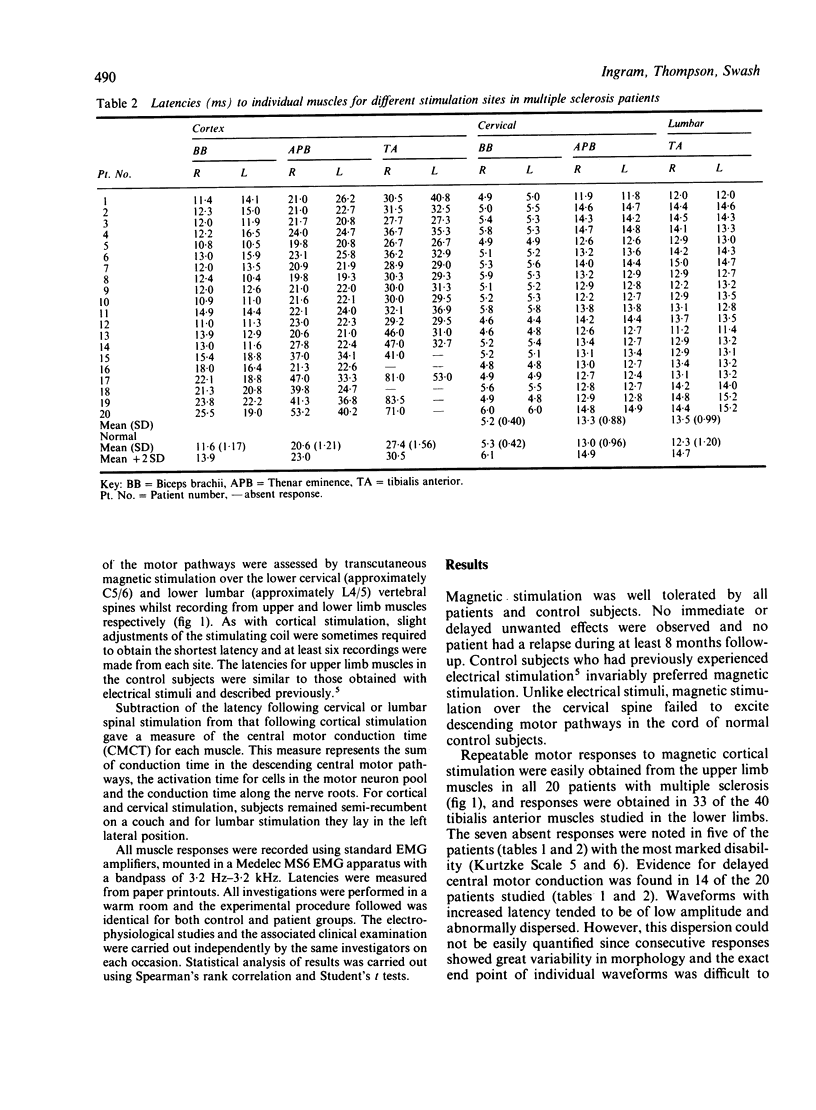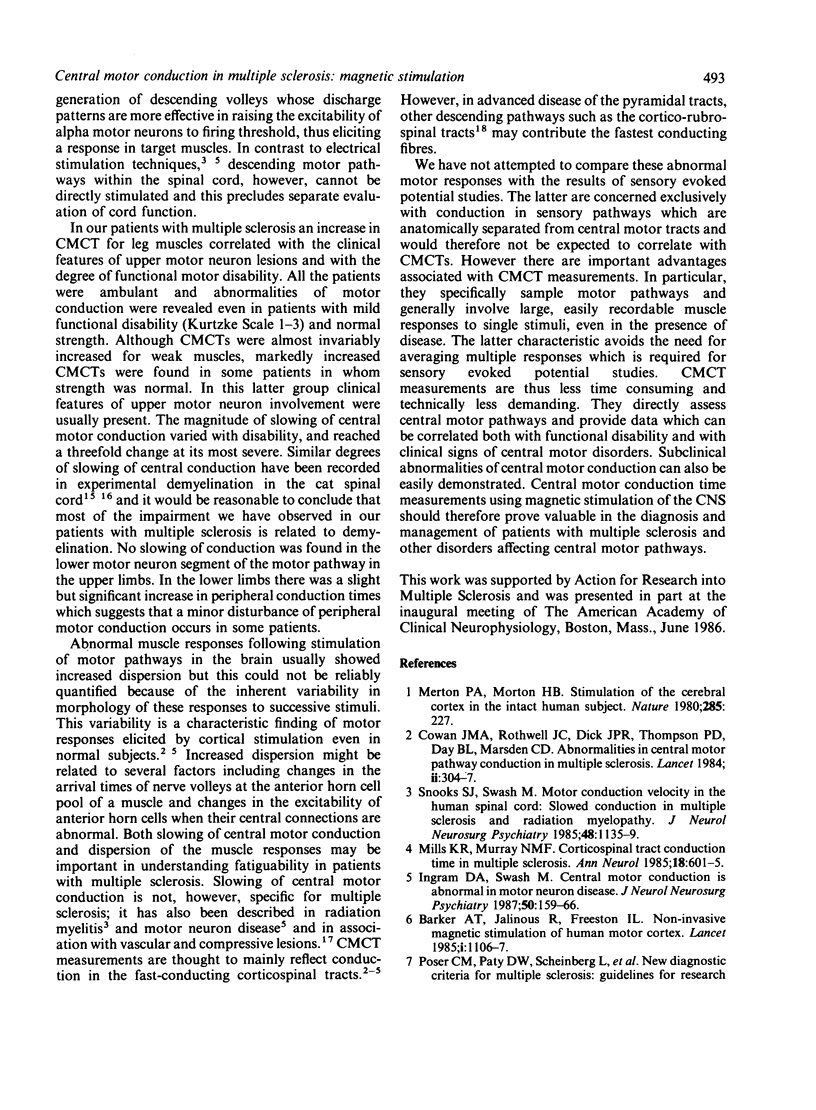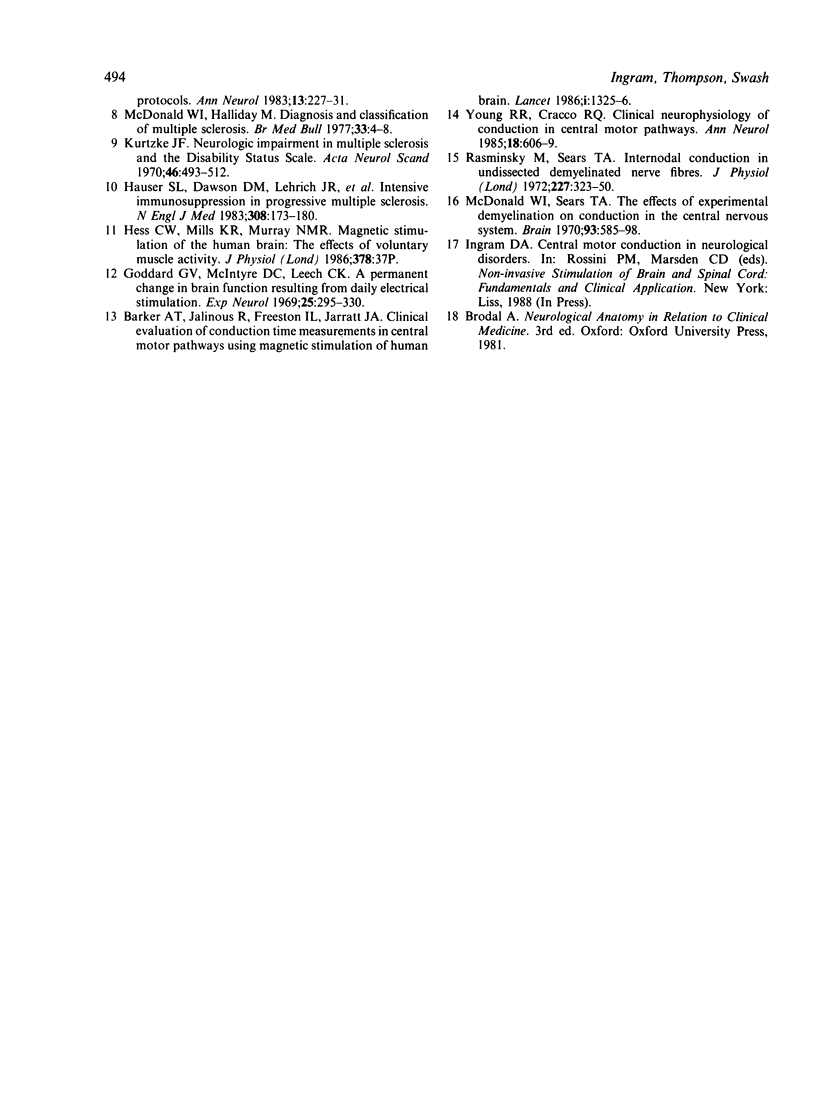Abstract
Magnetic stimulation of the brain and spinal column was used to assess conduction in the descending central motor pathways controlling arm and leg muscles of 20 patients with multiple sclerosis, and 10 normal subjects. The multiple sclerosis patients had relapsing and remitting disease but all were ambulant and in stable clinical remission. Increased central motor conduction times (CMCTs), up to three times normal, were frequently encountered in multiple sclerosis patients and in leg muscles these correlated closely with clinical signs of upper motor neuron disturbance; in the upper limb muscles a higher proportion of subclinical lesions was present. Weak muscles were almost invariably associated with abnormal central conduction but increased CMCTs were also found for 52 of the 104 muscles with normal strength. CMCTs for lower limb muscles were directly related (p less than 0.005) to functional motor disability (Kurtzke and Ambulatory Index Scales). No patient developed clinical evidence of relapse during follow-up of at least 8 months. Magnetic brain stimulation is easy to perform, painless, and safe, and provides clinically relevant information in the diagnosis and monitoring of multiple sclerosis patients.
Full text
PDF







Selected References
These references are in PubMed. This may not be the complete list of references from this article.
- Barker A. T., Freeston I. L., Jabinous R., Jarratt J. A. Clinical evaluation of conduction time measurements in central motor pathways using magnetic stimulation of human brain. Lancet. 1986 Jun 7;1(8493):1325–1326. doi: 10.1016/s0140-6736(86)91243-2. [DOI] [PubMed] [Google Scholar]
- Cowan J. M., Rothwell J. C., Dick J. P., Thompson P. D., Day B. L., Marsden C. D. Abnormalities in central motor pathway conduction in multiple sclerosis. Lancet. 1984 Aug 11;2(8398):304–307. doi: 10.1016/s0140-6736(84)92683-7. [DOI] [PubMed] [Google Scholar]
- Goddard G. V., McIntyre D. C., Leech C. K. A permanent change in brain function resulting from daily electrical stimulation. Exp Neurol. 1969 Nov;25(3):295–330. doi: 10.1016/0014-4886(69)90128-9. [DOI] [PubMed] [Google Scholar]
- Hauser S. L., Dawson D. M., Lehrich J. R., Beal M. F., Kevy S. V., Propper R. D., Mills J. A., Weiner H. L. Intensive immunosuppression in progressive multiple sclerosis. A randomized, three-arm study of high-dose intravenous cyclophosphamide, plasma exchange, and ACTH. N Engl J Med. 1983 Jan 27;308(4):173–180. doi: 10.1056/NEJM198301273080401. [DOI] [PubMed] [Google Scholar]
- Ingram D. A., Swash M. Central motor conduction is abnormal in motor neuron disease. J Neurol Neurosurg Psychiatry. 1987 Feb;50(2):159–166. doi: 10.1136/jnnp.50.2.159. [DOI] [PMC free article] [PubMed] [Google Scholar]
- Kurtzke J. F. Neurologic impairment in multiple sclerosis and the disability status scale. Acta Neurol Scand. 1970;46(4):493–512. doi: 10.1111/j.1600-0404.1970.tb05808.x. [DOI] [PubMed] [Google Scholar]
- McDonald W. I., Halliday A. M. Diagnosis and classification of multiple sclerosis. Br Med Bull. 1977 Jan;33(1):4–9. [PubMed] [Google Scholar]
- Merton P. A., Morton H. B. Stimulation of the cerebral cortex in the intact human subject. Nature. 1980 May 22;285(5762):227–227. doi: 10.1038/285227a0. [DOI] [PubMed] [Google Scholar]
- Mills K. R., Murray N. M. Corticospinal tract conduction time in multiple sclerosis. Ann Neurol. 1985 Nov;18(5):601–605. doi: 10.1002/ana.410180514. [DOI] [PubMed] [Google Scholar]
- Poser C. M., Paty D. W., Scheinberg L., McDonald W. I., Davis F. A., Ebers G. C., Johnson K. P., Sibley W. A., Silberberg D. H., Tourtellotte W. W. New diagnostic criteria for multiple sclerosis: guidelines for research protocols. Ann Neurol. 1983 Mar;13(3):227–231. doi: 10.1002/ana.410130302. [DOI] [PubMed] [Google Scholar]
- Rasminsky M., Sears T. A. Internodal conduction in undissected demyelinated nerve fibres. J Physiol. 1972 Dec;227(2):323–350. doi: 10.1113/jphysiol.1972.sp010035. [DOI] [PMC free article] [PubMed] [Google Scholar]
- Rønne T. Measles virus infection without rash in childhood is related to disease in adult life. Lancet. 1985 Jan 5;1(8419):1–5. doi: 10.1016/s0140-6736(85)90961-4. [DOI] [PubMed] [Google Scholar]
- Snooks S. J., Swash M. Motor conduction velocity in the human spinal cord: slowed conduction in multiple sclerosis and radiation myelopathy. J Neurol Neurosurg Psychiatry. 1985 Nov;48(11):1135–1139. doi: 10.1136/jnnp.48.11.1135. [DOI] [PMC free article] [PubMed] [Google Scholar]
- Young R. R., Cracco R. Q. Clinical neurophysiology of conduction in central motor pathways. Ann Neurol. 1985 Nov;18(5):606–610. doi: 10.1002/ana.410180515. [DOI] [PubMed] [Google Scholar]


